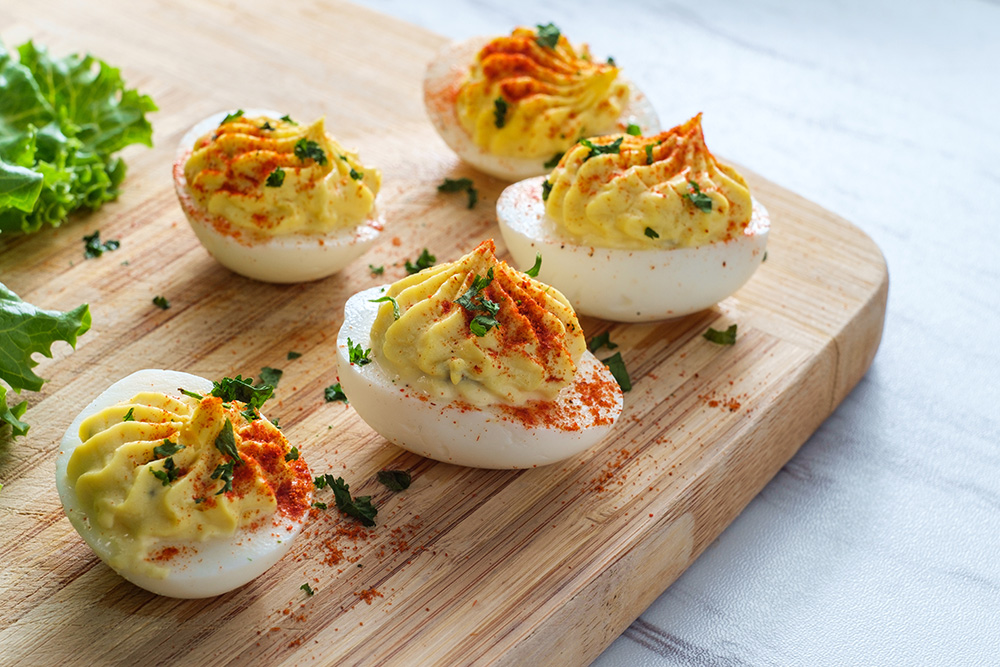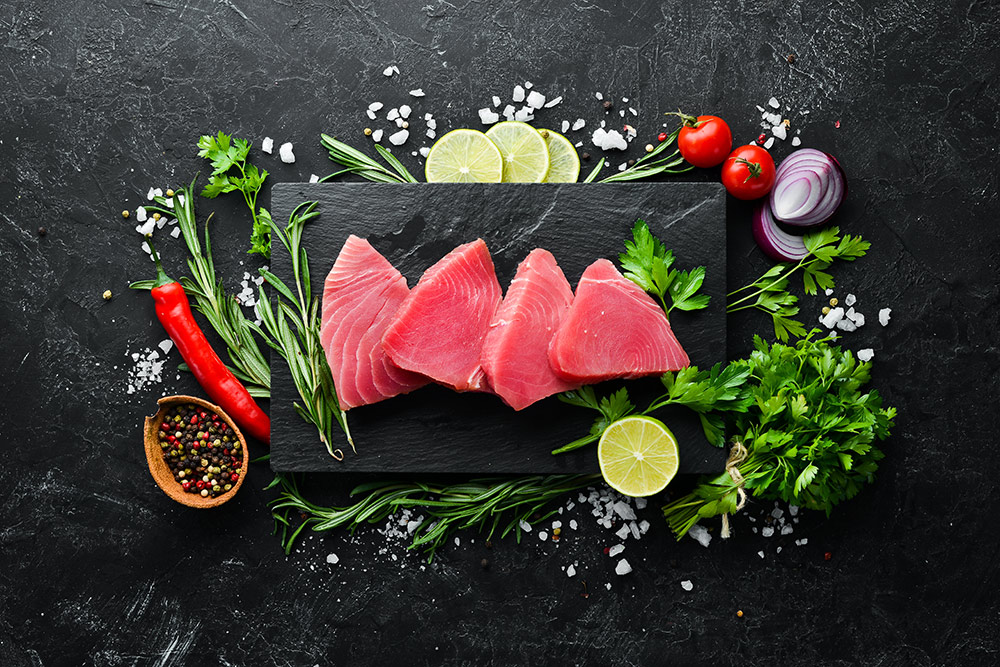Mediterranean Deviled Eggs, Spotlight on Anchovies, Perfect Hard-Boiled Eggs, The Truth About Eggs, and How to Balance Exercise and Eating
In this issue we’ll cover how to finally achieve the perfect hard-boiled egg for the oh-so-classic hors d’oeuvre—deviled eggs, but with a Mediterranean spin.
Mediterranean Deviled Eggs
 Mediterranean Deviled Eggs
Mediterranean Deviled EggsThey say what’s old is new again, and that’s definitely true about the classic hors d’oeuvre deviled eggs. But I like to put a Mediterranean spin on this popular canape with heart-healthy extra virgin olive oil as the enrichment rather than the original, butter. Olive oil not only adds creaminess, but a delicious spiciness, too. And adding a variety of garnishes lets you get super creative and give your platter of deviled eggs a festive look. Enjoy!
Ingredients
- 12 hard-boiled eggs, peeled
- 2-3 tablespoons extra virgin olive oil
- 3 tablespoons mayonnaise
- 1 tablespoon Dijon-style mustard
- 1 tablespoon minced shallot or onion
- 1 tablespoon flat-leaf parsley, rough chopped
- 2 teaspoons fresh lemon juice, preferably from a Meyer lemon
- 1 anchovy or 1/2 to 1 teaspoon anchovy paste
- 1/2 clove garlic, minced
- Sea salt and freshly ground black pepper
- Your choice of garnishes (ideas below)
Directions
Step 1
Cut the eggs in half lengthwise, remove the yolks and transfer them to the bowl of a small food processor. (Alternatively, use an electric hand-held mixer.) Put the egg white halves on a deviled egg platter or other oversized dish.
Step 2
To the bowl with the yolks, add 2 tablespoons of the olive oil, the mayonnaise, mustard, shallot or onion, parsley, lemon juice, anchovy, and garlic and process until fairly smooth. Add salt and pepper to taste and the remaining tablespoon of olive oil if the mixture is too thick.
Step 3
To pipe the filling into the egg white halves, place a resealable plastic bag into a tall drinking glass and turn the edges over the rim of the glass. (For an extra fancy touch, place a wide fluted pastry tip in one of the lower corners.) Fill the bag with the yolk mixture and seal the bag after pressing out any air. Snip off one of the lower corners and then gently squeeze a generous amount of the filling into the egg white halves. If you don’t have enough filling for all the whites, chop the remaining ones and enjoy them in a salad. Garnish the deviled eggs with your choice of olive slices, slivers of sun-dried tomatoes, drained brined capers, chopped chives, good-quality anchovies, basil chiffonade, caviar and/or a sprinkle of pimentón (Spanish smoked paprika). I like to pick four to six options, depending on what I have on hand. Cover and refrigerate until you’re ready to serve. The deviled eggs can be made up to four hours in advance.

Healthy Ingredient Spotlight
Anchovies
When it comes to anchovies, you either love them or you haven’t really tried them or your experience has been with poor-quality anchovies packed in poor-quality oil, and they were overly fishy. If that’s the case, I say it’s time to try again because anchovies impart the all-important “fifth taste,” umami, to dishes. They also typically disappear as they meld into other ingredients—this is especially true when added to a sauce or a sauté. Buy best-quality anchovies in a jar that, once opened, will keep for a few weeks in the fridge, or get a tube of anchovy paste for even easier use.

Healthy Kitchen Nugget
Perfect Hard-Boiled Eggs
Want perfectly round centers on your hard-boiled eggs? The day before cooking, place the eggs on their sides in their carton. To make peeling easier, cook eggs by placing them directly from the refrigerator into boiling water. Then lower the heat to a simmer to avoid the usual “boil-over.” I like to cook them for 12 minutes and then plunge them into cold water to stop the cooking process and chill them down quickly. Gently crack the shell all around and peel under running water.

For Your Best Health
Are Eggs Good for Me, or Not?
It seems that there are as many studies on the effects of eggs on health as there are days in the year, with the results of new studies often contradicting prior findings! Take the study published in February 2021 in the journal PLoS Medicine. Researchers analyzed self-reported egg-eating for the year 1995 from a pool of more than a half-million retired Americans and then looked at the incidence of heart disease and diabetes and deaths over the next 16 years. Of all the foods recorded on participants’ questionnaires—124 to be exact— the study pointed a finger at previously exonerated eggs as the culprit for those ills. But a group of experts queried by the British group Science Media Centre, which provides interpretation and statistical analyses of scientific studies, said “not so fast.”
“The most important drawback of this study was the way egg consumption data was collected. What and how much food people ate was asked just once, and people were asked to recall what they had eaten in the past. This is problematic because people tend to forget; also their diets might change a lot, particularly if they became ill,” said Ada Garcia, PhD, one of the experts and a senior lecturer in Public Health Nutrition at the University of Glasgow in Scotland. “Studies that observe diet and lifestyle behaviours are useful to understand whether what we eat is linked to becoming ill or dying, but they are not conclusive. We eat a combination of foods and one specific part of the diet—in this case, whole eggs—cannot be fully blamed. The key thing to remember is to keep a balance in what we eat and what we do: Eating a variety of healthful foods, avoiding overeating or indulging in foods that are too high in sugar and energy, keeping an eye on how much salt we eat. Being overweight or obese, smoking, consuming too much alcohol, and not being physically active are much more important factors to consider for prevention of chronic diseases and related deaths. The conclusions of this study are overblown. Blaming eggs alone for an increased risk of cardiovascular disease is a simplistic and reductionist approach to the concept of diet and disease prevention.”
Another point to make is that many studies have acknowledged that cholesterol from foods like eggs doesn’t translate to high blood cholesterol and its health consequences—that’s due more from saturated fat. But when it comes to buying eggs, there’s a different type of confusion—this time surrounding which are the healthiest. According to the Cleveland Clinic’s Kristin Kirkpatrick, RD, LD, USDA labels don’t always tell the whole story. For instance, “organic eggs” sound great and tell you that the chickens weren’t given growth hormones, but not whether they had antibiotics or were raised humanely. “Free-range” and “free-roaming” don’t indicate the quality of the hens’ outdoor space or how often they were able to access it. “Cage-free” doesn’t tell you how crammed they might have been in the chicken house. On the other hand, she points out that “pasture-raised” means the chickens were free to hunt for their food and, as a result, their eggs tend to naturally have more omega-3 fatty acids and the antioxidant lutein—you can tell by the deeper yolk color. She points out that the gold standard for humane treatment is a stamp on the egg carton that says “animal welfare approval.” The silver medal goes to the “certified humane” designation. Want really fresh eggs? Check out small farmers in your area and visit them to check out the operation for yourself, she suggests.

Fitness Flash
Balancing Exercise and Eating
Could exercise be making you fatter? Exercise is an essential part of good health, but when it comes to calories, a brisk 30-minute walk, for example, only burns off somewhere between 150 and 200 calories. Yes, that can help with weight loss efforts, but here’s the rub—most people overestimate exercise’s calorie burn, plus they tend to reward themselves with food afterwards and actually take in more calories than they used in working out. This behavior was confirmed by an experiment conducted by scientists from the Technical University of Munich (TUM) and the University of Nebraska. They compared the amount of food that study participants ate after exercise as well as after a rest period.
“We were able to show for the first time that certain characteristics, such as the amount and ‘urgency’ with which a person wants to eat, change over the course of physical exertion,” said Karsten Köhler, PhD, assistant professor in exercise, nutrition, and health at TUM. “The actual results suggest that physical exertion can entice those who do sport to eat larger amounts of food more quickly after the training session. Since weight loss is a main motivation for exercising for many, and failure to achieve the desired weight loss makes it likely to quit exercising, it could be a good strategy to think about what you want to eat afterwards before you start to exercise.”
For instance, have yogurt and fruit at the ready instead of reaching for an oversized muffin. The research team is now looking at other strategies that could make exercise a more substantial part of weight loss.
Get More Recipes In Your Inbox!

